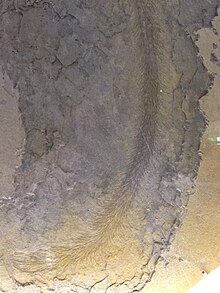Baragwanathia
| Baragwanathia Temporal range:
| |
|---|---|

| |
| Fossil of Baragwanathia found in Victoria, Australia | |
| Scientific classification | |
| Kingdom: | Plantae |
| Clade: | Tracheophytes |
| Clade: | Lycophytes |
| Order: | †Drepanophycales |
| Family: | †Drepanophycaceae |
| Genus: | †Baragwanathia W.H.Lang & Cookson, 1935 |
| Species | |
| |
Baragwanathia is a genus of extinct lycopsid plants of Late Silurian to Early Devonian age (427 to 393 million years ago), fossils of which have been found in Australia, Canada, China and Czechia. The name derives from William Baragwanath who discovered the first specimens of the type species, Baragwanathia longifolia, at Thomson River (Victoria, Australia).[2]
Description
Baragwanathia differed from such taxa as were trilete isospores. The gametophyte of Baragwanathia is currently unknown.
The species Baragwanathia brevifolia, described in 2017 from a single fossil specimen, had smaller microphylls than other species of Baragwanathia. It had marine species (bryozoans and brachiopods) attached to it, and apparently growing on it, showing that at least the lower part of the plant grew in marine water. As it is one of the oldest lycophyte fossils, the implication is that land-based lycophytes evolved from aquatic precursors.[3]
Age
The age of Baragwanathia has been uncertain because the fossils described by Lang and Cookson (1935) at first appeared to be of Late Silurian age, associated as they were with the
See also
Notes
- ^ Rickards (2000).
- ^ Lang & Cookson (1935), p. 425.
- ^ a b Kraft & Kvaček (2017).
- ^ Lang & Cookson (1935), p. 422.
- ^ Jaeger (1966). Since then, conodont studies have confirmed the Early Devonian age.
- ^ Rickards (2000), and earlier papers referred to therein. See Yea Flora Fossil Site.
- ^ Hueber (1983).
References
- Hao SG and Gensel PG (2001) The Posongchang Floral Assemblages of Southeastern Yunnan, China - Diversity and Disparity in Early Devonian Plant Assemblages. In Plants Invade the Land. Evolutionary and Environmental Perspectives, pp. 103–119. Eds PG Gensel and D Edwards. (Columbia University Press, New York).
- Hueber, F.M. (1983). "A new species of Baragwanathia from the Sextant Formation (Emsian) Northern Ontario, Canada". Botanical Journal of the Linnean Society. 86 (1–2): 57–79. .
- Jaeger, H. (1966). "Two late Monograptus species from Victoria, Australia, and their significance for dating the Baragwanathia flora". Proceedings of the Royal Society of Victoria. 79: 393–413.
- Kraft, Petr & Kvaček, Zlatko (2017). "Where the lycophytes come from? – A piece of the story from the Silurian of peri-Gondwana". Gondwana Research. 45: 180–190. .
- .
- Rickards, R.B. (2000). "The age of the earliest club mosses: the Silurian Baragwanathia flora in Victoria, Australia" (abstract). Geological Magazine. 137 (2): 207–209. S2CID 131287538. Retrieved 2007-10-25.
